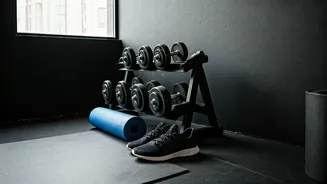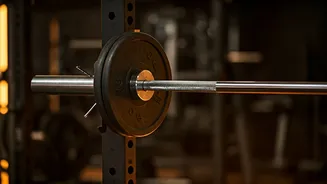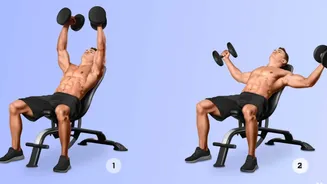Grip and Setup
The initial setup is critical for a successful close-grip bench press. Start by positioning yourself on the bench so your eyes align directly beneath the bar.
A slightly narrower grip than shoulder-width is ideal. This grip will shift the emphasis to your triceps. Before you begin to lift the bar, ensure that your feet are firmly planted on the floor to provide a stable base, which is crucial for generating power. Your back should have a slight arch, creating a natural curve. This is not only for support but also to help you effectively utilize your bodyweight throughout the lift. Finally, take a deep breath, and set your shoulder blades to create a solid foundation for the exercise. Now you’re ready to start the movement.
Executing the Lift
Once you have set up, it's time to begin the close-grip bench press. First, unrack the bar and keep it aligned over your chest. Slowly lower the bar to your lower chest, ensuring your elbows stay tucked in close to your body. As the bar descends, maintain this controlled motion. Then, gently tap the bar on your chest to keep control. Push the weight back up powerfully. Engage your triceps as you press the weight upward. Fully extend your arms at the top of the movement. This complete extension maximizes muscle engagement. Remember to control the eccentric phase (lowering) and the concentric phase (lifting) for optimal muscle growth. Repeat this movement for the desired amount of repetitions. This methodical approach will help in building not only strength but also promote muscle development.
Benefits of the Press
The close-grip bench press offers a wealth of benefits that extend beyond mere aesthetics. This exercise is incredibly effective for triceps development because it puts direct stress on the triceps muscles, which aids in muscle growth. It also helps to enhance overall upper body strength, particularly in the pushing muscles, and this can translate to improvements in other lifts. Furthermore, it contributes to better shoulder stability. The exercise promotes shoulder joint health by strengthening the muscles that support the shoulder joint. The close-grip bench press will also improve your bench press performance in general. Strengthening the triceps directly supports your ability to push heavier weights, so integrating it into your workout routine is a wise choice for anyone seeking overall fitness gains.
Avoiding Mistakes
To fully unlock the potential of the close-grip bench press, it's important to sidestep some common errors. One major mistake is flaring the elbows too wide. This action can put unnecessary strain on the shoulder joints and reduce the effectiveness of the exercise. Make sure to keep your elbows tucked in during the entire movement to focus the work on the triceps. Another frequent mistake is bouncing the bar off the chest. This is both inefficient and risky. Instead, maintain a controlled descent and lightly touch the chest. Always ensure that the barbell is lowered to a point on the chest where it can be controlled, and where the triceps and other relevant muscles can efficiently move the weight back up. Poor foot placement also affects your stability. Ensure you establish a solid base by planting your feet on the floor. Finally, using an excessively wide grip. This shifts the focus away from the triceps and puts strain on the shoulders.
Integrating into Routine
To optimize your training, include the close-grip bench press strategically in your workout plan. It's often performed after bench press or other compound exercises like incline bench press. Aim for 3 to 4 sets of 6 to 12 repetitions to maximize muscle growth. This rep range is ideal for building both strength and muscle hypertrophy. You can adjust the weight based on your current strength levels. Don't increase weight too quickly. Pay close attention to your body and adjust as needed to avoid injury. Varying the rep ranges will also provide your body with the required challenge for sustained progress. Listen to your body and incorporate adequate rest days. This will promote muscle recovery. Ensure you get proper rest and nutrition to support muscle growth. By combining proper form, strategic integration, and attentive listening to your body, you can create a powerful, effective workout regimen for building impressive upper body strength.












